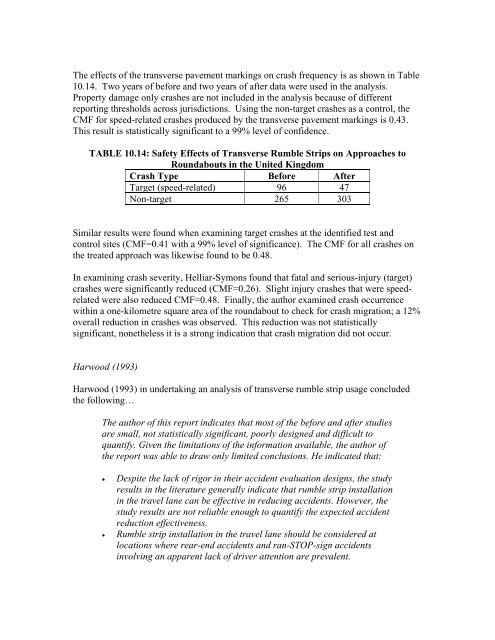Synthesis of Safety for Traffic Operations - Transports Canada
Synthesis of Safety for Traffic Operations - Transports Canada
Synthesis of Safety for Traffic Operations - Transports Canada
You also want an ePaper? Increase the reach of your titles
YUMPU automatically turns print PDFs into web optimized ePapers that Google loves.
The effects <strong>of</strong> the transverse pavement markings on crash frequency is as shown in Table<br />
10.14. Two years <strong>of</strong> be<strong>for</strong>e and two years <strong>of</strong> after data were used in the analysis.<br />
Property damage only crashes are not included in the analysis because <strong>of</strong> different<br />
reporting thresholds across jurisdictions. Using the non-target crashes as a control, the<br />
CMF <strong>for</strong> speed-related crashes produced by the transverse pavement markings is 0.43.<br />
This result is statistically significant to a 99% level <strong>of</strong> confidence.<br />
TABLE 10.14: <strong>Safety</strong> Effects <strong>of</strong> Transverse Rumble Strips on Approaches to<br />
Roundabouts in the United Kingdom<br />
Crash Type Be<strong>for</strong>e After<br />
Target (speed-related) 96 47<br />
Non-target 265 303<br />
Similar results were found when examining target crashes at the identified test and<br />
control sites (CMF=0.41 with a 99% level <strong>of</strong> significance). The CMF <strong>for</strong> all crashes on<br />
the treated approach was likewise found to be 0.48.<br />
In examining crash severity, Helliar-Symons found that fatal and serious-injury (target)<br />
crashes were significantly reduced (CMF=0.26). Slight injury crashes that were speedrelated<br />
were also reduced CMF=0.48. Finally, the author examined crash occurrence<br />
within a one-kilometre square area <strong>of</strong> the roundabout to check <strong>for</strong> crash migration; a 12%<br />
overall reduction in crashes was observed. This reduction was not statistically<br />
significant, nonetheless it is a strong indication that crash migration did not occur.<br />
Harwood (1993)<br />
Harwood (1993) in undertaking an analysis <strong>of</strong> transverse rumble strip usage concluded<br />
the following…<br />
The author <strong>of</strong> this report indicates that most <strong>of</strong> the be<strong>for</strong>e and after studies<br />
are small, not statistically significant, poorly designed and difficult to<br />
quantify. Given the limitations <strong>of</strong> the in<strong>for</strong>mation available, the author <strong>of</strong><br />
the report was able to draw only limited conclusions. He indicated that:<br />
• Despite the lack <strong>of</strong> rigor in their accident evaluation designs, the study<br />
results in the literature generally indicate that rumble strip installation<br />
in the travel lane can be effective in reducing accidents. However, the<br />
study results are not reliable enough to quantify the expected accident<br />
reduction effectiveness.<br />
• Rumble strip installation in the travel lane should be considered at<br />
locations where rear-end accidents and ran-STOP-sign accidents<br />
involving an apparent lack <strong>of</strong> driver attention are prevalent.
















